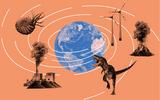MEK – J2 T2 1 – Concrete – versatile but problematic artificial stone
From concrete, a direct line can be traced back to the seas of the Jurassic period: this artificial stone is made of cement, water, sand and gravel. Cement is produced from limestone and marl – raw materials which derive from Jurassic marine organisms such as molluscs and starfish.
To build up their calcareous shells, these organisms bound carbon dioxide CO2 – as they still do today – through a complex chemical process.
When the ancient limestone is heated to produce cement, the CO2 contained in the shells is released into the atmosphere again. Thus, as with the burning of coal, oil and natural gas, a long-gone world poses a threat to our future.
Our world is shaped and influenced by the ubiquitous artificial stone, concrete. Since the 1930s, its global volume has increased 60-fold.
If the volume of concrete produced annually was poured over the city of Bern, the layer would be around 240 metres thick – more than twice as high as the cathedral.
The majority of carbon dioxide CO2 emissions come from the burning of coal, oil and natural gas. The next biggest source is cement production (5–8%).
Researchers and industry are constantly testing various methods for reducing the greenhouse gas emissions associated with cement production, or capturing the CO2 generated.
